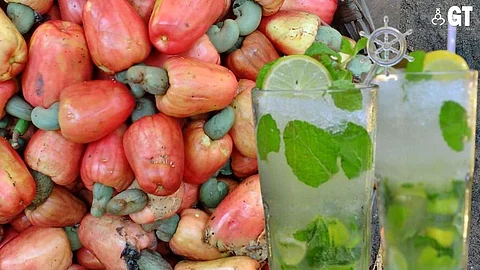

The journey from being a bucolic drink to claiming shelf space in the suave and even pretentious saloons of urban Goa has been a long one for urraca. But once it took that first step up the rung, there was no holding back as the drink, with thousands of its fans cheering in unison, tenaciously and swiftly scaled that ladder.
Urraca, the drink that has a shelf life of merely a few weeks, has winked at its rivals to reach out from the shelves of the taverna licenciada of rural Goem to the hipster barrooms of touristy Goa.
Even if only for that brief period when all revolves around the first distillate of the cashew apple juice, urraca has displayed some special seductive powers that could lead one to having a long-time affair with the drink when all that the person had been looking for was nothing more than a one-night stand.
Handwritten posters stating ‘fresh urrak available here’ can be seen outside bars and on roadsides, while more hip posts – visual, audio, video – with messages about the drink’s availability appear on social media. To the uninitiated, there are even videos on what to mix with urraca.
When did this revolution happen? When did urraca go from being a drink that the urban elite would wrinkle their noses at to becoming the darling of the connoisseurs? For urraca was once not the drink of the elite.
Maria Pia Rodrigues in the essay ‘Taverna and its socio-economic impact in colonial Goa’ quotes Cottineau Kloguen who visited Goa in the 1820s as stating, ‘the richest have soup and boiled and roast meat and always finish by rice and curry before the desert which consists of cakes and sweetmeats; they drink Madeira, Lisboa and other Portuguese wines; those less easy take no soup but never omit the curry and they drink urraca’.
Rodrigues, in the same essay and though she does not mention urraca, does talk of feni and native drinks and so notes, ‘Native drinks were not much served in the halls of westernised Goan elite.
It was a matter of prestige for them to offer European drinks. However, in rural areas and among the common people, feni occupied an important place in every social and religious function, like weddings, funerals, litanies, village feasts and other social events.’
Of course, with urraca available just three months of the year, it would not be possible to serve it at all occasions.
Mac Vaz of Big Boss feni brand in a chat pointed out that it was the Goan diaspora and the nouveau Goans settled in Goa who were, what he termed, ‘the key ambassadors of urraca’, to create a pan-India vibe for the drink.
There is corroboration of this in an article by Hansel Vaz, founder of Cazulo Premium Feni, who in goya.in wrote, ‘Urraca, for the longest time, was written off, either because of the taboo of its ‘country spirit’ mantle — which, in this country is still proving hard to shrug off — or because people in our country have never been accustomed to low-strength spirits.’
And then it happened. Sometime in the past decade the drink surged into the upscale alcohol markets to become hugely popular.
Mac Vaz of Big Boss feni brand in a chat pointed out that it was the Goan diaspora and the nouveau Goans settled in Goa who were, what he termed, ‘the key ambassadors of urraca’, to create a pan-India vibe for the drink.
‘Feni is an acquired taste,’ said Mac, ‘but urraca, when you have it with Limca is a great drink for a first-timer. It is light, it is fruity and it is low in alcohol content. Those are some of the key reasons for the drink getting popular.’
In that Mac is right. Urraca, the word, does conjure certain feelings in Goans who have sipped this brew that is mellow, fruity and low on alcohol.
Its many fans will confirm that it is possible to fall in eternal love with it after just a few sips, a reason why as February comes to a close its aficionados will be sniffing around for the distinct aroma that tells them where urraca is available.
Its many fans will confirm that it is possible to fall in eternal love with it after just a few sips, a reason why as February comes to a close its aficionados will be sniffing around for the distinct aroma that tells them where urraca is available.
And so urraca emerged from the shadow of feni to claim its place in the Goan sun. Perhaps when the taverna licenciada died its natural death, when bars and restaurants opened in their place, it was but a natural corollary that the poor man’s brew would tickle the tastebuds of the rich man.
It happened, as Mac pointed out, with tequila and with gin in their home regions. And it has so happened in Goa with urraca.
The drink has turned fashionable and, in a State where somebody is always finding fault with change, for once not even a whisper of a complaint has been audible. In contrast, what is heard is a cheer and then some more!